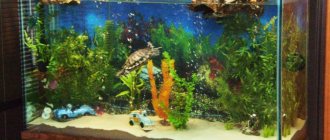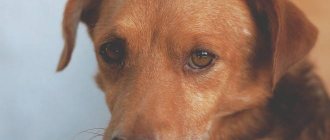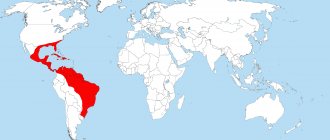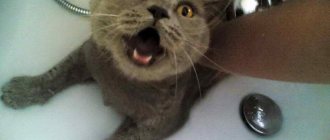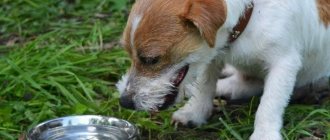Water bowl
Surprisingly, the material from which it is made also affects the health of your dog. You should absolutely not use technical plastic - it is toxic and releases toxic components into the water that are not excreted from the body.
Its microscopic doses accumulate. Glass and ceramic bowls are also undesirable - they break easily, and a temperamental dog will definitely break it.
The size of the bowl is also important - a large dog needs it larger than what is used for small breeds.
Thirst of pathological origin
But everything is not always so harmless; often the dog begins to drink a lot due to the fact that a disease develops in his body. And drinking plenty of food in this case is a protective reaction of the body, protecting it from possible dehydration.
The list of diseases of which polydipsia is a symptom includes the following ailments:
- hypercalcemia (increased calcium levels in the plasma part of the blood);
- hypocalcemia (pathological decrease in calcium levels);
- diseases associated with hormonal levels (diabetes mellitus and insipidus, thyrotoxicosis, acromegaly);
- tumor formations in liver tissue, as well as other oncological diseases;
- inflammatory processes in the liver (hepatitis);
- accumulation of purulent-inflammatory fluid in the uterine cavity;
- hypothalamic diseases;
- manifestation of pericardial effusion;
- increase in red blood cells in the bloodstream;
- renal failure in acute or chronic form;
- inflammation of the kidneys (pyelonephritis);
- glomerular nephritis;
- urethral obstruction.
Since there are many diseases that cause polydipsia, owners should not try to diagnose the disease on their own. It would be better to seek advice from a specialist.
Why do puppies refuse to drink?
Usually, owners see that dogs gradually empty the water bowl and add water, replacing it with fresh water. If the owner notices that the dog has not touched the liquid during the day, this does not mean that the alarm should be sounded immediately. When your pet gets a lot of fluid from food, and this happens with natural feeding (soups, kefir, yoghurts, milk porridge), there is no need to worry. This means that the amount of fluid entering the body per day is enough for him. If the dog refuses to drink the next day and does not approach the water container, then this may be evidence of a deterioration in his health.
We need to quickly find out the cause of the problem, because, in fact, dehydration occurs in the body of the tailed animal: cells starve, nutrients do not dissolve, blood thickens, waste accumulates. The above reduces the defenses of the young pet’s body. He stops drinking fluids for many reasons. One of them may be food poisoning. Puppies are curious by nature and can swallow completely inedible substances, which leads to poisoning. Also, the entry of a foreign body into the stomach can cause a refusal to drink. Intestinal obstruction, viral infections, inflammatory diseases of internal organs can be a causative factor.
The owner needs to remember how the puppy behaved in the last 24 hours, what happened to him, whether he was exposed to medications, chemicals or other dangerous substances. It is quite possible that he walked outside your field of vision for a long time and swallowed a foreign object.
It is necessary to pay attention to other alarming signs in the condition of a young pet, for example, redness of the eyes, loss of appetite, lethargy. In this case, you need to go to an appointment with a specialist at a veterinary clinic or invite him to your home, if possible.
Before being examined by a doctor, the puppy needs to wet his mouth with water to moisturize his mucous membranes, and place him in a cool place if this happens during the hot period of the year. When a veterinarian discovers a serious illness in a dog, he will most likely prescribe drips for the tailed patient to restore the water-salt balance.
Stress is the cause of many diseases and pathological conditions in pets. The dog may refuse to eat and drink for the same reason. Emotional experiences in young pets can occur after physical punishment or long separation from the owner, after the appearance of another animal or a newborn in the house. In the latter case, the animal instinctively experiences jealousy or fear of becoming unnecessary.
If your young pet refuses water and feels well, then you should pay attention to the quality of the liquid itself. Maybe you rarely change it? Purebred dogs are very picky about cleanliness and do not like food debris floating in the water.
Maybe the puppy doesn't drink much because he doesn't like boiled water? It doesn't quench your thirst. And sometimes tap water is highly chlorinated, which causes dogs to reject it. Since the healthiest well water for growing dogs is not available in urban areas, offer them filtered bottled water. It must be changed twice a day.
How much fluid do dogs need per day?
There are recommended water intake rates for dogs per day. The norm is 50 ml per kilogram of weight. Based on this figure, you need to control how much water your ward consumes. This norm increases in the hot season, when the dog eats less and drinks more; during physical activity; after operations. By the way, young pets and females consume more fluids than males, since their metabolism is increased and active. Aging dogs, those over 8 years old, also drink a lot, because their bodies do not retain moisture well.
In this article I will talk about the reasons why dogs refuse to drink and eat. I will describe the dangers associated with insufficient food and fluid intake, the reasons why you don’t drink water, and what to do even if your nose is cold. Why is the dog lethargic and lying down, no appetite, constantly sad and how to treat it. Let me explain when it is necessary to contact a veterinarian. I will give the norms for water consumption and how much to drink for the animal.
Water is a chemical element necessary and indispensable for the health and functioning of a living organism. Participates in all life processes: structure, development, metabolism, removal of toxins, etc.
Why won't my dog eat??
Your dog may stop eating food for a variety of reasons, be it health or psychological. If you continue to refuse food after 2-3 days, you should take your dog to the vet for a proper examination and diagnosis. Here are some situations in which a dog may stop eating:
- The dog is not eating, but is drinking water. This could simply be a poor appetite or it may be related to your dog's eating habits. Perhaps you are used to eating treats or people food and don't want to eat dog food. If this continues for more than a day, contact your veterinarian.
- The dog is vomiting or has diarrhea. : If your dog refuses to eat and is vomiting yellow bile or you have diarrhea, this may indicate an infection or digestive disorder, so take your dog to the vet if it lasts more than an hour.
For a more comprehensive list, read our article on why your dog isn't eating or drinking.
Sometimes a dog may stop eating for psychological reasons . For example:
- Newly Adopted Dog While adjusting to the changes to its new home, a newly adopted dog can go several days without eating or even urinating. Try to keep your dog as comfortable as possible and offer him a varied and healthy diet. You will soon learn their preferences. If your dog is still not eating after the first few days, contact your veterinarian.
- Food Changes : If we change your brand of dog food or switch to a natural diet, when your dog is used to processed food, he may refuse to eat at first. Changes to your dog's diet should always be gradual.
- Stress or anxiety
Changes in daily life, such as vacations or strangers in the house, can cause stress in your dog. The dog may stop eating or refuse to eat for several hours or a day. Try to make any changes gradually and calm your dog if he seems stressed or anxious.
In the last section we will discuss other methods and tips for helping your dog start eating again if the dog is not eating for physiological or behavioral reasons.
If you have adopted a puppy that is stopping or refusing to eat, take a look at this article that explains why your puppy isn't eating.
How long can a cat live without water?
A cat can live without access to water for a day, then changes will begin to occur in its body. Life expectancy without water is determined by several factors:
- 1. Diet. If your cat eats dry food daily, then it needs to be provided with plenty of fluids. In wet food, she receives liquid that lasts for several days.
- 2. Time of year. In summer, a cat needs more water than in winter.
- 3. Breed. British breed cats drink very little, the rest - depending on their state of health.
- 4. Water norm and age. Adult animals drink more water than kittens.
A cat’s body consists of 70% water; an animal dies faster from an imbalance of water than from a lack of food. The daily dose of water for an adult pet is 300 ml. If the drinking regime is not followed for 2 days, the functioning of the cat’s internal organs slows down.
Possible reasons
A dog's refusal to eat may be due to the following reasons:
- In hot weather, dogs often eat poorly and prefer to lean on liquids. In such situations, it is worth providing your pet with constant access to water, adding soups to their diet, and preventing dehydration or overheating.
- A sedentary lifestyle is a common cause of loss of appetite.
- Females may temporarily refuse to eat during menstruation .
- Monotony in diet can offend your pet and push him to refuse the food he has eaten. Just like a person, a dog needs a varied and balanced menu.
- During the period of changing baby teeth, puppies may eat less frequently.
- The reason for refusing certain types of products may be the genetic predisposition of the breed.
- In the end, your pet may, unnoticed by you, profit from something during a walk or simply steal a treat from your poorly hidden supplies.
Do not be afraid of short fasts - they are beneficial for the animal.
If after a break your pet asks to eat again, do not rush to pamper him and give him an increased portion.
Next, we will consider a number of common situations associated with a pet’s refusal to eat.
Hand food only
Why doesn't a dog eat from a bowl, but eats from your hands? The reasons may be the following:
- fear;
- disgust;
- habit.
Firstly, your pet may be afraid to approach the bowl. His fear may be caused by some situation from the past that greatly frightened him, associated specifically with this bowl or other similar object.
A dog with a strong sense of smell may disdain the bowl if it smells like detergent. This is a justified reaction: the remains of the product on poorly washed dishes will clearly not benefit the animal if it gets into its stomach along with food.
You should rinse the bowl thoroughly and use environmentally friendly detergents.
In addition, if a dog that is accustomed to feeding from the floor is suddenly offered to eat from a dish, it will most likely follow its established habit: it will carelessly steal or tip its contents onto the floor.
Dehydration
When a pet refuses to eat for a long time and stubbornly, compassionate owners often have a question: how long can a dog live without food?
The endurance of dogs in this part is comparable to that of humans: they can live up to two weeks without food, and up to 4 days without water. Death from dehydration occurs much faster than from starvation, so prolonged thirst can cause much more damage to health than hunger .
A dog can fast for 1-2 days without harming its health , provided it drinks enough water.
Large individuals tolerate hunger much more easily.
This is due to the difference in metabolic rate compared to small breeds.
When hunger lasts more than 3 days, changes occur in the pet’s body that lead to damage to health that is difficult to compensate. An animal that has reached this stage of hunger needs an urgent visit to the veterinarian.
About water quality
In early childhood, each of us was taught to drink boiled water, why? Because the water in the tap is “dirty”. Many people have probably wondered why clean and even sometimes tasty water is called bad. Growing up, many began to drink water from the tap... and nothing bad happened. So why do parents “instinctively” boil water for their children? Where did this “tradition” come from?
In fact, there is no mystery in boiling water. An adult knows that his mother, grandmother, and great-grandmother boiled water and repeats this ritual because “it’s necessary.”
In fact, the procedure of boiling water allows you to completely clean it of helminth eggs and partially of:
- Salt.
- Alkalis.
- Chlorine.
- Hydrogen sulfide.
The key word here is partial, because depending on the region, the condition of reservoirs and treatment plants, water may contain pesticides, heavy metals, nitrates and many other unpleasant components. Unfortunately, most people (if we are not talking about developed countries) have industrial water flowing from their taps that is unsuitable for drinking and cooking.
There are many opinions about the dangers and benefits of tap water. Some people fanatically call bottled water dead, others do not risk cooking with tap water because it leaves behind scale. We will not participate in this dispute; we will only talk about the facts that we know.
Manufacturers of bottled water do not hide the composition of their product, but there are some nuances. You don’t go to a sedum plant before buying water, you don’t check whether everything is as the manufacturer claims, and you don’t submit the water for laboratory analysis. You trust your sense of taste, at best, check whether scale remains after using purchased water. If there is no plaque or scale, the water is automatically recognized as purified. In most cases, this method is quite reliable and there is a reason for this.
Purified water producers do not extract their product from wells. The raw material is tap water, which is passed through several filters and then, at the request of the manufacturer, ionized, mineralized or enriched in another way. Only mineral water is extracted from wells.
Most people make guesses about the composition of tap water, but few people get around to checking their intuition, that is, having the water analyzed. Fortunately, there are methods to keep running water safe, including:
- Use water filters.
- Install a permanent filtration system (reverse osmosis).
- Boil water, which will eliminate most of the harmful substances.
The next question is what kind of water can you give your dog and is it tap water? General recommendations are as follows: if the tap water in your city is not of disgusting quality, it can be given to your dog. How you assess the condition of the water is a personal matter. As a last resort, you can use water for your pet. It is interesting that these recommendations contradict the instructions of modern experts, who advise giving pets only purified water (through a filter or purchased). Who is right?
The instructions are as follows: take water into an open container, let it stand in a dark place for at least a day (during this time the residual chlorine will disappear), carefully pour 2/3 of the water (top layers) into a clean container, pour out the rest of the water (there is sediment in it)
It is important to carry out the procedure carefully so that settled solids do not mix with the upper layers of water
Everyone is partially right. A dog should not be given only purified water (this means from birth and throughout its life), since sooner or later it will be tempted to drink water from a puddle or someone else's bowl. If the animal's intestinal microflora is not ready for bacterial invasion, the dog will be poisoned. You should not give only tap water, especially if you are caring for an old dog or a pet with a predisposition to pathologies of the genitourinary system. In this case, maintaining health and reducing the burden on the body is a more important factor.
So, the conclusion is the following - it is important to find a middle ground and not go to extremes. It is equally important to monitor the dog’s health and the amount of water it consumes.
It is advisable to focus on your pet’s preferences, that is, give him the water that he drinks better.
Factors affecting the lifespan of dogs
In addition to belonging to any breed, a dog’s age is influenced by the genetics of the genus. The fewer dogs there were with health problems, the higher the likelihood of getting a long-lived pet.
The influence of a dog's physiology on a dog's life was briefly mentioned. It's not just body weight that affects health. Its structure also plays a role. Hounds and greyhounds, for example, have long legs. This affects the speed of running after prey and senile sores. With age, greyhounds' limbs become brittle and the bones wear out.
Caring for the animal also plays an important role. It partly depends on the breed. General rules include a balanced diet, ensuring proper physical activity and pet hygiene.
Proper care is especially important during the first 2-3 years of life, at the stage of formation of the body. Vaccinations help protect your dog from a number of diseases. There is a mandatory schedule and a list of additional vaccines used at the request of the owners.
The final “note” in the matter of a dog’s health is the situation in the house, relationships with the owners. Four-legged animals also experience depression, stress, and a depressed state, as well as an elated, calm state. Dogs react to violence in the family and towards themselves, to the indifference of their owners. Psycho-emotional “levers” trigger the development of certain diseases.
How long can a cat and cat live without food and water?
When talking about how long a cat can live without water and food, it is worth taking into account the health and age of the animal. It is obvious that an adult and healthy individual can more easily tolerate a forced head, in contrast to, say, sick, weakened pets and kittens.
Adult healthy pet
An adult animal can go without food for about 10 days.
The lack of water is more critical for the cat, but even in this case it will live for 5–6 days. Of course, the length of these periods should not reassure attentive owners. It is normal if a cat refuses to eat and drink for 2 days, after which the body becomes exhausted, and to save the pet’s life, measures must be taken, the nature of which depends on the reasons that caused the hunger strike.
Adult sick or weakened pet
Lack of appetite or refusal of water by a sick pet is a dangerous sign, since such an animal can live no more than 3 days. Refusal of a weakened cat from food and water for more than a day is a serious cause for concern.
Old cat or cat
As cats age, their metabolism slows down, and their protective and adaptive capabilities become much worse. Therefore, any refusal of food and water in animals over 8 years of age should be considered a serious pathology. An old cat can live without food and water for no more than 5 days.
Kitty
Kittens are born very weak and are highly dependent on living conditions, nature and frequency of feeding. Newborn pets cannot live without food, which for them is also water, for 10 hours. Older kittens are stronger, but for them this period is no more than 3 days. In any case, children’s refusal of food and water should be considered a serious problem that threatens their life and health.
Consequences
Even if the dog goes through a period of prolonged starvation and thirst, this will not pass without leaving a mark on its health. In the best case scenario, irreversible changes will still occur in the body, resulting in dystrophy and digestive disorders. The first sign of these pathologies is failure of first the hind limbs and then the forelimbs. Only a qualified doctor can help such a dog, so if detected, you need to take it to the clinic as soon as possible. A pet in critical condition should absolutely not be given water or food.
Important! If it is not possible to provide a malnourished animal with quick veterinary care, you need to help him yourself. To do this, it is necessary to inject 10 ml of saline solution subcutaneously with a break of 1 hour so that the dog can survive until the meeting with the veterinarian.
If for some reason the pet has not eaten for just a couple of days, then it needs to be fed with a moderate portion of porridge with meat. If you refuse food for 3 days, the dog should be immediately shown to the veterinarian, since this is a consequence of internal pathological processes or will lead to the development of such.
To keep your pet in good shape, you should not leave him without food for more than a day. It is very important to regularly provide him with high-quality food and clean water. Without food and drink, an animal can quickly get sick and die, so its diet must be treated with due attention.
How long can a small dog live without food and water? And how much with food, but without water?
If it is of such poor quality that you do not risk using it as food for yourself, you should not give it to your dog either. In this case, pass the water through a filter or give it settled boiled water. You can also give bottled water that you use for cooking yourself.
An important point is that water, even the best, should not stagnate in the bowl. It needs to be changed, even if the dog hardly drinks it.
Water should always be fresh; this is very important for the health of your pet. Bacteria multiply quickly in stagnant water; even when boiled, dust settles and spoils.
It must be changed at least once a day, preferably more often.
How many days can a dog live without food?
Unfortunately, not all owners try to be the best for their pets. There are times in life when a dog is simply thrown out into the street in winter, where it finds itself in harsh conditions without water and food, or the owners, having gone on summer vacation, simply forgot about it. Unfortunately, such cases are not uncommon. It will be very good if at this moment caring people are nearby and try to take care of the shaggy comrade.
The dog may also simply be experiencing extreme stress due to the fact that he had to be alone, without his owner (the owner is on a long-term business trip, or he died), and then feeding him will be a very big problem. An animal may not touch a bowl of food and water for days.
So how long can a dog live without food? It is very difficult to give an exact answer, because more and more often it depends on many factors.
Rating of dry dog food
Reasons that can aggravate the situation of a dog if it is without food:
- Lack of water - without its presence, an animal’s chances of survival are reduced significantly.
- The dog is sick - it is in such cases that it will very rarely enjoy eating; the vast majority refuses to even look in the direction of its bowl.
- Winter - in the cold, most of the energy is spent on heating the animal, so the smaller the dog, the more often it needs to eat in order for it to survive.
- The physical condition of the dog and its size. If she was eating normally and drinking enough fluids before going without food, her chances of survival increase significantly. Also, its viability is influenced by body characteristics and size - larger dogs are more resilient and will be able to last a little longer without food.
Dogs' cousins, wolves, when in the wild, can go quite comfortably without food for about three weeks and without water for about a week.
Our pets - dogs - have less endurance and, on average, will “live” on water alone for no more than two weeks, and without water - no more than four. Of course, there were cases when a dog sat without water or food in an apartment for more than 10
days, but it is impossible to say that she was completely without food and water, since she could have found something to eat or drink water from the toilet. We are considering the case where the dog’s access to water and food is completely limited: it is tied or locked somewhere.
Even if a dog has survived without food for such a long time, many irreversible processes can begin in its body. At best, she will survive, but symptoms such as dystrophy, rickets, and chronic digestive problems will remain forever.
After several weeks of starvation and dehydration, in most cases the dog's paws give out - first the hind legs, then the front ones.
And, unfortunately, such a test often cripples the animal for the rest of its life, and only an experienced veterinarian can give a second start in life after everything it has experienced.
List of Hypoallergenic Dog Foods
So if you find an extremely emaciated dog, immediately take it to the veterinarian; you are not able to help it yourself. This also applies to those whose pets suddenly refused food.
If more than two days have passed and the dog has not touched the food bowl, you should visit the veterinarian. Otherwise, you will have to treat your pet for a number of digestive system diseases.
For the normal condition of the animal, it is not recommended to leave it hungry for more than a day. Happiness to you and your four-legged friends!
What can aggravate the condition of a hungry dog?
First of all, there is a lack of water. In this case, the chances of survival are sharply reduced. You already know how many days a dog can live without food. It is clear that in some cases you can count on a successful outcome. But if she does not have water for more than 1-2 days, then the condition will very soon become critical.
What other factors can aggravate the animal’s condition:
- Disease. In severe cases of viral diseases, the animal refuses to even look towards the bowl, and very soon will stop drinking water.
- Winter is on the street. In this case, most of the energy will be spent on heating. The smaller the dog, the more often it needs to eat to survive.
- Physical condition and size. If a large and healthy animal is left without food, it will last much longer.
Danger
Some risk factors:
- By-products for dogs do not undergo such careful control as products for humans, so there is a chance of buying spoiled or infected meat.
- If your dog eats too quickly, he will swallow his paws just as quickly, which can cause choking. So before feeding, the chicken feet will have to be crushed with a hammer.
- Tubular bones can also harm the dog; carefully inspect the food so as not to injure your pet.
Is it possible for small pets?
The growing body also needs nutrients, which can be provided by chicken feet, heads and other offal.
Considering the unformed immune system and jaw apparatus, it is better to chop and boil the paws to reduce the chance of infection to zero. Just in case, remove the claws to prevent the puppy from getting hurt.
Pregnant or nursing
Adults, mature individuals, as well as pregnant and lactating women, can consume them in unlimited quantities, since the need for nutrients is doubled
It is also worth paying attention to the claws and tubular bones; if the paw is large, break its bone in half with a cleaver or hammer
REFERENCE! For adult dogs, meat does not need to be cooked, since raw meat contains a large amount of iron, fluorine and microorganisms necessary for the normal functioning of the body.
There is no need to be afraid that the infection in the meat will get into the membrane of the fetus, because it will pass the mother’s immune barrier, the lymphatic system, the protection of the gastrointestinal tract, the immune barrier of the fetus, and its lymphatic system. After completing such a series of infections, there is practically nothing left.
How long can a cat live without water?
All living organisms consist almost entirely of water, in the case of a cat - 70%. A decrease in this level by 10 percent or more triggers the development of irreversible processes that end in death. So how many days can a cat live without water? A young, healthy individual can live no more than 5 days without consequences for the body. Elderly individuals and kittens can withstand a little more than 24 hours in the absence of liquid.
The body's water balance is affected not only by age, but also by climatic conditions. For example, in hot weather the need for water increases, in winter it decreases slightly. The type of food matters: dry food requires more fluid intake, and a noticeable desire to drink begins after 24 hours.
Experienced cat owners not only change water daily in convenient wide bowls, but also leave water containers around the perimeter of the apartment or an open toilet lid in case of unforeseen circumstances. With water that has settled for several days, you can water your indoor plants.
Additional Information! Pet stores sell automatic drinking bowls for cats that fill the bowl with water as it becomes empty.
Automatic cat waterer
How long can a dog go without food???
When it comes to the daily life of our pets, an adult dog can go 2-3 days without food , without this it is bound to be a big problem. A healthy adult dog can live up to 5 days without food. However, food is what provides your dog with nutrients and energy, and poor eating habits will harm his health in the long run. Even if there is nothing wrong with it, try to help your dog regain his appetite.
If you have a puppy, an old or sick dog, or if you are not eating accompanied by symptoms such as diarrhea, fever or vomiting, take your dog to the vet immediately. If your dog seems healthy, he may want to wait a day as this may be a passing phase or a nuisance. Of course, try to get your dog to eat during this time, and make sure you continue to drink water.
As we already mentioned, in certain extreme situations, a dog can sometimes go weeks without food. For example, a dog that has been abandoned or trapped after an earthquake may survive several weeks without food. Of course, an old or sick puppy or dog will not last as long as a healthy adult dog. Size and breed can also affect a dog's ability to survive without food.
How long can a dog go without drinking water???
Although a dog can physically survive for several days without food, water is critical. Without drinking water, the dog will die in a couple of days. . A dog can live up to three days without water, but by then the dog will become dehydrated and reach a critical condition. Always make sure your dog has enough water, especially in the summer. If you notice signs of dehydration, take your dog to the vet.
How long can a parrot live?
Like humans, parrots have different tolerances to hunger and thirst. Like humans, he is much less resistant to thirst. Experts have long calculated the average life expectancy of a parrot in conditions of complete absence of water and lack of food.
Without water
The idea of some people that since the ancestral home of the parrot is in hot countries, then it needs relatively little water is fundamentally wrong. In fact, this species of birds loves water very much and needs it.
If the owner suddenly left the bird without water for a day, then it may show the first signs of dehydration. They may be:
- cold paws in a pet;
- sunken eyes;
- saggy skin on fingers.
If a pet has been without water for two days, then this is a critical limit. If you don’t give him something to drink immediately, he will most likely die on the third day. For an old, too young, or inexperienced pet, death will occur even earlier.
Without food
Veterinarians indicate that a domestic parrot can live without food for about 3-4 days. With prolonged fasting, his body is significantly weakened. A feathered pet may experience and develop the following symptoms:
- fading of feathers and their active loss;
- general lethargy;
- disruptions in the functioning of the digestive system;
- weakened immunity, which can lead to infection with various diseases.
It is important to remember that even if the parrot does not die from starvation, starvation will always have a negative impact on its health. He may well die from an illness resulting from a weakened immune system.
It is possible to avoid a situation of starvation when the owners are forced to leave. To do this, you need to choose one of the options;
- place as much water and food in the cage as possible if the owner needs to leave for a maximum of a day or two. At the same time, we must remember that overeating is also not beneficial for the bird;
- ask friends or relatives to look after your feathered friend while the owner is away;
- take your parrot to a shelter for a while.
What happens to the body
If an animal was in extreme conditions for a long period of time without access to food and water and survived, this will not be in vain for its health. Such tests cause irreversible consequences in the body. Even if the dog survives, he will feel the consequences of the hardships he endured until the end of his days, and will often get sick and suffer from chronic diseases.
Most often, as complications after forced fasting, an animal develops:
- chronic diseases of the digestive system;
- dystrophy;
- rickets.
If your dog doesn't drink enough water
Emotional condition. A dog that has suffered severe stress may not only refuse to eat, but also to drink.
Inflammation of the gums. The pain makes it painful for the dog to eat, and cold water leads to even more severe pain. Dental problems, such as advanced caries and plaque on teeth, can also lead to refusal of water.
Kidney failure can cause you to stop drinking water. The kidneys are simply not able to process large amounts of water.
Intestinal obstruction. The obstruction may be caused by a foreign object or an intestinal tumor.
The dog doesn't like water. It may be dirty or the bowl may be slimy.
Dog food and well-being
The digestion process in dogs is different from humans. Therefore, judging the correctness of an animal’s nutrition based on human standards is fundamentally wrong.
How long an animal can live without food and water depends on many factors
Food taken in by an animal begins to be digested only in the stomach, and not on the way to it, as in humans. In addition, the length of a dog's intestines is almost half that of a human's. Therefore, one of the main indicators of the quality of food for a dog is its rapid digestibility, because it takes the animal very little time to digest it. And the animal is not at all capable of digesting rough food.
The digestion process is the processing and transformation of nutrients received from food: proteins are broken down into amino acids, fats are converted into glycerol and fatty acids, and carbohydrates are converted into glucose. Once absorbed, these elements are used by the body as a source of energy. Therefore, when preparing an animal’s diet, it is necessary to take into account its daily energy requirement, based on breed, age, activity and physical capabilities.
If a dog does not eat for more than a day, this is a reason to contact a veterinarian.
Food must contain the right amount of proteins, fats and carbohydrates, since their lack can cause the dog to lose vitality and develop various diseases that become chronic. But an excess of energy causes the pet to become overweight, which turns into obesity. The consequence of this condition is often various cardiovascular diseases and problems with the musculoskeletal system.
